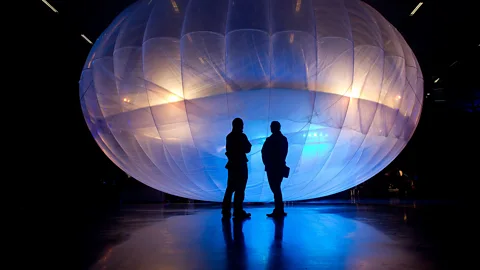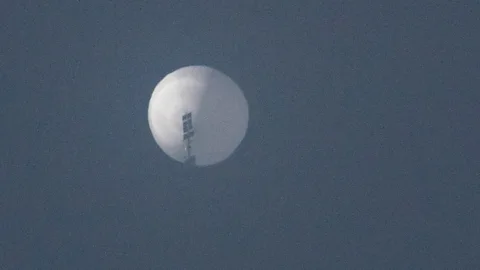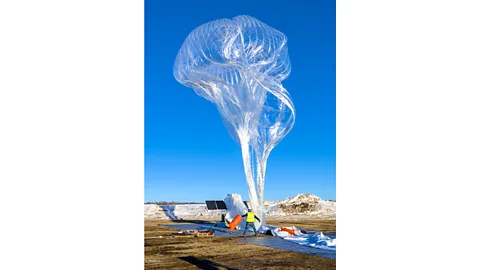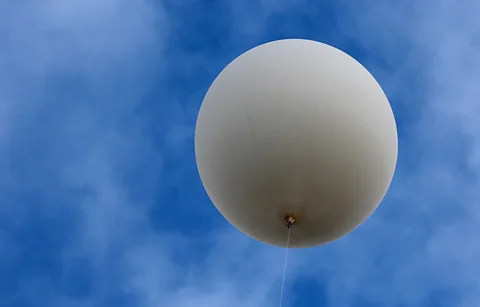Why balloons can fly higher, further and longer than planes
 Marty Melville/AFP/Getty Images
Marty Melville/AFP/Getty ImagesThe Chinese balloon that drifted across the US last week flew far higher than passenger jets. How high and how far can they travel?
In May 2002, a balloon launched from the Sanriku Balloon Centre (SBC) in the north of Japan, quietly broke every absolute height record humanity had ever set.
It quickly floated past the height achieved by the first successful balloon ascent in 1783 – It crept past the 1901 balloon flight which reached 10.8km (35,433ft) and led to the discovery of the stratosphere. It glided past every height record ever set by any kind of aircraft, be it helicopter, propellor-driven plane or jet.
The balloon even went higher than the record-breaking height achieved by former Google executive Alan Eustace in 2014 when he ascended by balloon to 135,899ft (41.4km) before he stepped outside the capsule and skydived to Earth.
It continued to ascend, through the upper reaches of the stratosphere into the mesosphere, which includes the coldest part of the atmosphere. Here, temperatures can drop to around -143C (-225F) – colder than any temperature ever recorded on Earth's surface.
You might also like:
The balloon finally reached a height of 53km (173,900ft) above the surface. Only objects launched via rocket or fired out of cannons have soared higher. It's balloons, rather than aircraft, that have taken humans and their scientific instruments closest to the edges of space.
These seemingly simplistic aeronautical devices can take instruments and equipment into places no other aircraft can, and stay there for longer.
In the days after a suspected Chinese surveillance balloon was shot down as it drifted at nearly 18km (60,000ft) above the United States, BBC Future looks at just why balloons are often the go-to choice of scientists, internet companies, weather forecasters and potentially government spy agencies.
How high can balloons go?
Those balloons reaching high altitudes – such as the record-setting 2002 balloon, or the Chinese one which caused the diplomatic incident with the US this month – are obviously a different breed to the hot air balloons used for joyrides. What does it take to make a craft capable of getting so high – and staying up once it's there?
 Reuters
ReutersRuss Van Der Werff of US high-altitude balloon makers Aerostar has a better idea than most. Van Der Werff, the company's vice-president of stratospheric solutions, is an engineer heading the team designing balloons to use kilometres above the realm of airliners. Raven Aerostar have worked in both the defence and commercial sectors, and designed the balloons for Google's emergency internet project Loon. (Read more about how Google's balloons surprised their creators.)
Over the last 10 years, the Aerostar has launched more than 3,000 balloons, and refined the way it builds them along the way. "We've done different formulations of plastics. And we have a couple of proprietary things that we've that we use now that are significantly better than what we were using 10 years ago. The other thing is how that plastic is seamed or welded together is a special process that we've put a lot of iteration into."
These improvements not only help the balloons fly higher, but also help them stay aloft longer. "Just to give you some kind of an idea, Thunderhead, which is our current commercial product offering, we have done flights out past 150 days in duration with a single balloon now. And with Loon, our record by the end was 320 days. So those are numbers that we definitely did not have 30 years ago, and the materials and manufacturing techniques have made a big difference in that lifetime duration." The Loon project was cancelled in 2021, but Van Der Werff says he expects his company will soon be able to launch a balloon that will stay aloft for a full calendar year.
The Chinese balloon shot down this week after covering thousands of miles of the Pacific and the continental US shows the enormous distances such balloons are capable of covering. How high they can travel also depends on how well the balloon carrying the payload is made.
Watch the video above to learn why spy balloons are still useful in era of drones and satellites
Loon's fleet of balloons, carrying communications technology that would allow mobile coverage in remote or disaster-affected areas, were designed to operate at a height of 19-25km (62,700-82,500ft). That's twice as high as most airliners fly at, and appreciably higher than almost all but the most specialised military jets.
What do high altitude balloons carry?
Depending on what their mission, these balloons carry anything from scientific measuring equipment through to communications equipment or – if spying's their game – sensors or cameras for observing the ground below them. It's a challenging environment to design equipment for, Van Der Werff says. "Designing electronics for a balloon is a lot like designing electronics for a spacecraft. The atmosphere at just 90,000ft (27.2km) is about 1% density it is here.
"It gets very cold up there, we'll get down to minus -80C (-112F)," he says. "But what's amusing and interesting is that, typically speaking, when people design electronics for the stratosphere, they actually have more trouble keeping it cool than keeping it warm, because there's [next to] no air up there. So, you can't blow a fan across the heatsink to move thermals out. The flip side of that challenge is this stuff all boots up and gets running on the ground. So, you have to operate in that environment and then transition to that other environment [at 90,000ft], which is a challenge."
 Raven Aerostar
Raven AerostarKeeping those electrical instruments running more than 20km above the Earth's surface isn't easy, either. "Most aviation today is powered still by fossil fuels," says Van Der Werff. "When you burn jet fuel, you have a lot of power. Most electronics sensors, communication gear that's designed for aircraft consumes a lot of power, because power is just not a big constraint on most aircraft."
Balloon carried instruments require a different solution.
"We take in all of our energy through solar during the day, charge up batteries, and then drift through the night and batteries," Van Der Werff says. "And then when we manoeuvre the balloon up and down, we use an electrically powered compressor that can pull like up to 800W. There's a real design constraint around energy use for the sensors for the kit, communications kit."
How do you control a balloon like this?
Changing a balloon's course at such heights is difficult, too. Van Der Werff says that the best way is to move the balloon up and down, where it can take advantage of the stratosphere's unique properties. "It's called stratosphere because there are different layers of different atmospheric properties in there. What we found in flying all those balloons is that in those different altitudes, there's actually quite a bit of diversity in wind speed and direction. You have these different layers where the wind is blowing different directions."
Much of this was unknown until a few decades ago, and scientists and engineers are using algorithms in an attempt to predict stratospheric wind patterns.
It means that while a balloon can't "loiter" like an aircraft can by flying a racetrack pattern around a fixed point, it can take advantage of the different patterns of winds between these layers.
 Steve Randall
Steve Randall"If I can accurately model and predict the wind diversity in those different layers of the stratosphere, then I can change altitudes and sort of persist over an area," says Van Der Werff. "And as long as I am close enough to the thing I'm trying to measure, observe, communicate – even if I'm wandering kind of semi aimlessly around that that target point – I'm providing a useful effect."
The cost
Balloons are much cheaper than a satellite sent up via a rocket – which makes them not only commercially viable, but also within the realms of dedicated amateur enthusiasts.
Steve Randall is one of them. Over the last 15 years, he's sent up more than 200 balloons from near his home in the east of England and helps run the high-altitude balloon company Random Engineering. The retired engineer, who previously built homemade rockets, says part of the appeal is that it's the closest that an ordinary member of the public can get to touching space.
"The sort of typical latex balloon probably goes to about 100,000ft (30.48km)," he says. "My highest flight was 45km (147,638ft). That gives you an idea of what's achievable." Higher flights are possible – as the Japanese proved in 2002 – but that comes with a heavier price tag.
"A typical latex balloon fly will just ascend and the balloon gets bigger because the atmosphere gets thinner and thinner, and the pressure drops," Randall says. "And so it just goes up and up and up until you get this point where it bursts. Then it parachutes down to the ground."
The distance they can travel while in the air makes them attractive. Balloons are not limited by fuel or battery power in the same way drones or aircraft might be. It can mean even very simple balloons can travel vast distances in the right wind conditions.
"You know, that might go, in the summer months, maybe 10 miles (16km)," says Randall. "In the winter it might be 500 miles (800km). I've personally had balloons land outside the UK."
High-altitude ballooning rarely makes the headlines in the way it has recently, but there are at least 1,800 weather balloons launched every day by meteorological stations around the world. Many have notes asking discoverers to return them to the appropriate facility – some even offer a reward.
"I've never lost I payload myself, I've got every single one that I've launched back," says Randall. "A balloon flight will go up, come down, maybe 50 miles (80km) away, and you'll recover it from a farmer's field somewhere. Sometimes it lands up a tree and you have to get the poles out and pull it pull it down."
Only one out of these balloons from the more than 200 he launched couldn't be recovered because it had landed too far up a tree – "climbing you know, 50ft (15m) tree to try and get it back was just bit too much" – but at least he knew where it had ended up.
--
